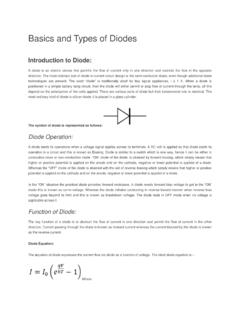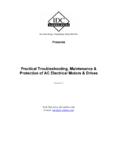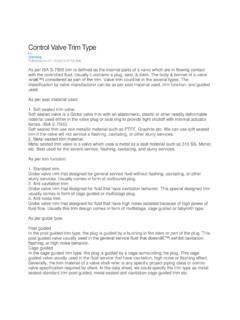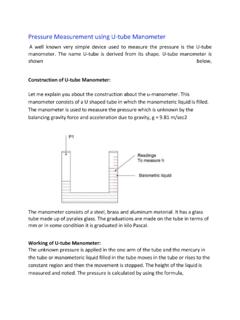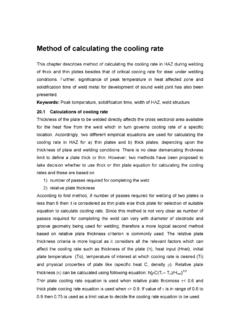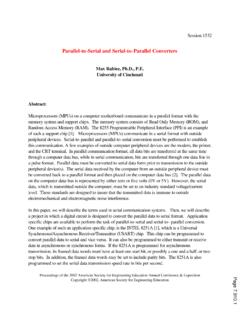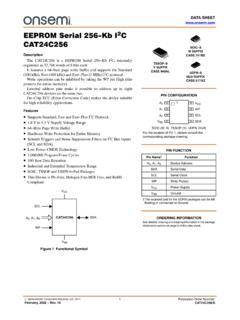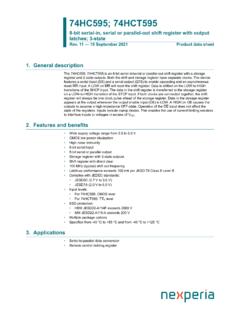Transcription of Serial Communication in Java with Example Program
1 Serial Communication in Java with Example Program Generally, Communication with Serial ports involves these steps (in no particular order): Searching for Serial ports Connecting to the Serial port Starting the input output streams Adding an event listener to listen for incoming data Disconnecting from the Serial port Sending Data Receiving Data I wrote an Example Program that includes all of those steps in it and are each in their own separate method within the class, but first I. will go through my hardware set up. Hardware Setup My current hardware setup is as follows: PC connected to an XBee Arduino connected to an XBee User input is given from the PC through the a Java GUI that contains code for Serial Communication , which is the code presented here. The Arduino is responsible for reading this data.
2 This set up is pretty much using my computer as a remote control for whatever device is on the Arduino end. It could be a motor control, on-off switch, etc. Existing Code The purpose of this post is to discuss Serial programming in Java, and not GUI's. However, I did create a GUI for testing purposes. See the Code Downloads section for the actual files. Above is the picture of the GUI complete with the buttons that I use to interact with the Program . I also added key bindings which I can use to control the throttle. When the Program is first started, none of the GUI elements will work except for the combo box and the connect button. Once a successful connection is made the controls are enabled. This is done through the use of the setConnected(true) and the toggleControls() methods shown in the Example code that follows.
3 Imports The imports i used for this Program were as follows: import *;. import ;. import ;. import ;. import ;. import ;. import ;. import ;. Depending on the Java IDE it might already know to tell you to use these imports except for the first one. That first import is specific to RXTX, and all its library methods/classes are in there. Class Declaration The code here reads: public class Communicator implements SerialPortEventListener I named my class Communicator, but the name is really up to the programmer. The name pretty much reflects its intended use. The class should also implement the SerialPortEventListener class. This is a class in RXTX and is required in order to receive incoming data. On some IDE's this may generate a public void method called serialEvent(). This method will be defined later.
4 Class Variables and Constants Below are the variables and constants that I defined in my class. What the variables are for is in the comments but a more detailed explanation will follow. //passed from main GUI. GUI window = null;. //for containing the ports that will be found private Enumeration ports = null;. //map the port names to CommPortIdentifiers private HashMap portMap = new HashMap();. //this is the object that contains the opened port private CommPortIdentifier selectedPortIdentifier = null;. private SerialPort serialPort = null;. //input and output streams for sending and receiving data private InputStream input = null;. private OutputStream output = null;. //just a boolean flag that i use for enabling //and disabling buttons depending on whether the Program //is connected to a Serial port or not private boolean bConnected = false.
5 //the timeout value for connecting with the port final static int TIMEOUT = 2000;. //some ascii values for for certain things final static int SPACE_ASCII = 32;. final static int DASH_ASCII = 45;. final static int NEW_LINE_ASCII = 10;. //a string for recording what goes on in the Program //this string is written to the GUI. String logText = "";. I could have easily put the variable definitions in the constructor but it wouldn't change anything. The GUI object is another class that I wrote separate from this one that contains all the GUI elements. The GUI class extends The Enumeration in Java is used for storing a series of elements of objects. In this case, the objects are CommPortIdentifiers (see Enumeration in the Reference Material). The HashMap is for mapping each of the ports' names to the actual object.
6 What that means is that I can associate (put() method) the name of a Serial port, say a string that says COM1, to an object in the code. Later, I can access the name COM1 from the HashMap by using theget() method and it will return the object that it was associated with previously. The CommPortIdentifiers object is needed to gather the list of ports that are available for connection. by using its getPortIdentifiers() method. The SerialPort object is for storing the data for the port once a successful connection is made. The InputStream and OutputStream is the object that is required for sending and receiving data. The Boolean variable bConnected is just a flag that I use for enabling and disabling elements on the GUI. The constant TIMEOUT is a number required when opening the port so that it knows how long to try for before stopping.
7 The constants for the ASCII values are some values that I use to send through the output stream that act as delimiters for data. The string logText is basically what the comment says. When stuff happens in the Program , the Program stores a string in this variable and it will be appended to a text area in the GUI. Searching for Available Serial Ports The method below is for searching for available Serial ports on the computer. Code adapted from Discovering Available Comm Ports from the Reference Material. //search for all the Serial ports //pre style="font-size: 11px;": none //post: adds all the found ports to a combo box on the GUI. public void searchForPorts(). {. ports = ();. while ( ()). {. CommPortIdentifier curPort = (CommPortIdentifier) ();. //get only Serial ports if ( () == ).}}
8 {. ( ());. ( (), curPort);. }. }. }. The method getPortIdentifiers() returns an Enumeration of all the comm ports on the computer. The code can iterate through each element inside the Enumeration and determine whether or not it is a Serial port. The method getPortType() can identify what kind of port it is. If it is a Serial port, then the code will add its name to a combo box in the GUI (so that users can pick what port to connect to). The Serial port that is found should also be mapped to the HashMap so we can identify the object later. This is helpful because the names listed in the combo box are the actual names of the object (COM1, COM2, etc), and so we can use these names to identify the actual object they are tied to. Connecting to the Serial Port The method below is for connecting to the Serial port once they have been found (see previous section).
9 See How to Open A Serial Port in the Reference Material for more information . //connect to the selected port in the combo box //pre style="font-size: 11px;": ports are already found by using the searchForPorts //method //post: the connected comm port is stored in commPort, otherwise, //an exception is generated public void connect(). {. String selectedPort = (String) ();. selectedPortIdentifier = (CommPortIdentifier) (selectedPort);. CommPort commPort = null;. try {. //the method below returns an object of type CommPort commPort = ("TigerControlPanel", TIMEOUT);. //the CommPort object can be casted to a SerialPort object serialPort = (SerialPort)commPort;. //for controlling GUI elements setConnected(true);. //logging logText = selectedPort + " opened successfully.";. ( );. (logText + "\n").}}
10 //CODE ON SETTING BAUD RATE ETC OMITTED. //XBEE PAIR ASSUMED TO HAVE SAME SETTINGS ALREADY. //enables the controls on the GUI if a successful connection is made ();. }. catch (PortInUseException e). {. logText = selectedPort + " is in use. (" + () + ")";. ( );. (logText + "\n");. }. catch (Exception e). {. logText = "Failed to open " + selectedPort + "(" + () + ")";. (logText + "\n");. ( );. }. }. Using the HashMap we can retrieve the CommPortIdentifier object from the string that was mapped earlier. This is achieved through the HashMap's get() method. The object must also be casted as a CommPortIdentifier because the get() method has a return type of Object. The setConnected method just changes a boolean flag so that the Program can store whether or not it is connected to a Serial port or not.
